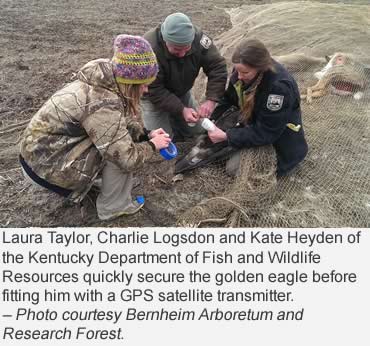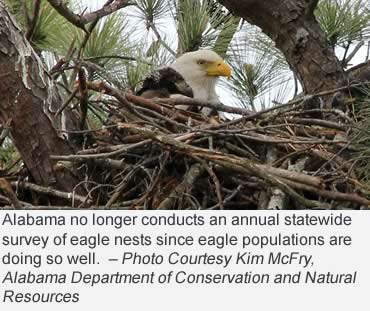Photo: Watch movements of the golden eagle captured in Kentucky on the Bernheim Forest website. – Photo Courtesy Billy Pope, Alabama Department Conservation and Natural Resources
Researchers recently captured a golden eagle in Kentucky’s Bernheim Forest in Bullitt and Nelson Counties and fitted it with a tracking device as part of an ongoing research project.
The news is exciting because golden eagles are seldom seen in Kentucky, although farther south in Tennessee and Alabama, golden eagles and bald eagles have increased in population.
“Bernheim Forest has a few golden eagles that come back every winter and it’s one of the more reliable places in the state to see golden eagles,” said Kate Heyden, avian biologist for the Kentucky Department of Fish and Wildlife Resources. “They don’t nest in Kentucky, but spend winters here. Golden eagles that winter here probably nest in Canada.”
The Kentucky researchers, including staff members of Bernheim Forest and Kentucky Fish and Wildlife, captured the adult male bird Feb. 10. Using a road-killed deer carcass as bait, the crew sat in a blind and fired a net over the golden eagle to capture it without harm.
“We banded, measured, sexed and aged the bird and put a custom-fitted solar powered satellite transmitter on its back that won’t interfere with flying, hunting or breeding,” Heyden said. “We hope to track this bird for three to five years.”
The installation of the tracking device is part of a larger study of eagles in the Appalachian Mountain region.
That project, coordinated by Dr. Todd Katzner at West Virginia University and the Eastern Golden Eagle Working Group, is designed to document the occurrences of Eastern Golden Eagles on wintering grounds.
The goal is to collect data on the birds year round and to provide detailed information on breeding locations. Read more about the study at here.
“Twenty years ago,” according to Carrie Threadgill, a nongame wildlife biologist for the Alabama Division of Wildlife and Freshwater Fisheries, “if people told me they saw an eagle in Alabama, I would have guessed it was probably just a vulture.
“Now, when people tell me they saw an eagle in the winter, I ask them, which species?
 “While we have an increasing number of bald eagles year-round across the state, we are actually discovering a small wintering population of golden eagles in Alabama.
“While we have an increasing number of bald eagles year-round across the state, we are actually discovering a small wintering population of golden eagles in Alabama.
In Kentucky, Kate Heyden reported, “there are more golden eagles in Kentucky than we thought, and this is the first one we’ve captured. This golden eagle is extremely healthy and one of the largest I’ve held, weighing 10 and a half pounds.”
Golden eagles typically show up in Kentucky, Tennessee and Alabama in late November and stay through March.
“The neat thing is we don’t know where it is going to go,” Heyden said. “We would like to see where it goes to nest. We expect this bird to migrate back to Canada.”
To follow the movements of this golden eagle visit the golden eagle page on the Bernheim Forest website.
Not only are golden eagles increasing in number in Alabama, but so are bald eagles, Threadgill said.
“While we have an increasing number of bald eagles year-round across the state, we are actually discovering a small wintering population of golden eagles in Alabama as well,” she added.
After the DDT was banned in 1972, eagles began to rebound slowly, but still could not be found breeding in Alabama. The pesticide caused eggshell thinning and devastated eagle numbers.
By 1984, Alabama’s Division of Wildlife and Freshwater Fisheries began a hacking program, releasing juvenile eagles from six different locations in the state with the hope they would establish nesting territories. Hacking involves releasing juvenile eagles at towers in certain locations to imprint them so they will return to those areas to breed as adults.
 During a 7-year period, 91 juvenile eagles were released, which resulted in increased nesting activity in Alabama. Thanks to the success of this program, eagles can now be seen nesting across the state.
During a 7-year period, 91 juvenile eagles were released, which resulted in increased nesting activity in Alabama. Thanks to the success of this program, eagles can now be seen nesting across the state.
Golden eagles tend to be more secretive than bald eagles, which are most often seen out in the open, usually near open water. Golden eagles are more of a forest species, and tend to stay close to forested areas, making it harder to locate those birds. They are found most often near ridge tops in forested areas.
New evidence suggests a separate eastern population breeds in eastern Canada and winters along the Appalachian Mountains and down into Alabama.
Alabama Wildlife and Freshwater Fisheries has conducted winter camera surveys through a collaborative effort with other agencies in 15 eastern states. Along with camera surveys, five adult birds have been trapped and radio transmitters attached to them to find out where those birds breed and migrate.
Alabama no longer conducts an annual statewide survey of eagle nests since eagle populations are doing so well, but residents with information or questions about nesting eagles or sightings of golden eagles, can contact Threadgill at carrie.threadgill@dcnr.alabama.gov.
– Resources provided by the Alabama Department of Conservation and Natural Resources, the Kentucky Department of Fish and Wildlife Resources, and the Tennessee Wildlife Resources Agency.